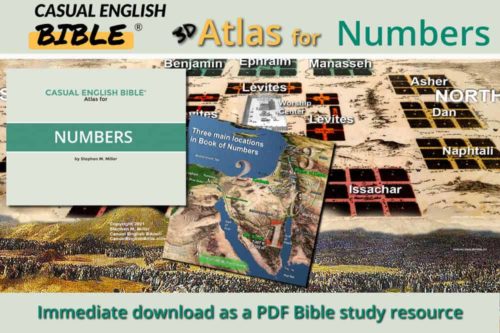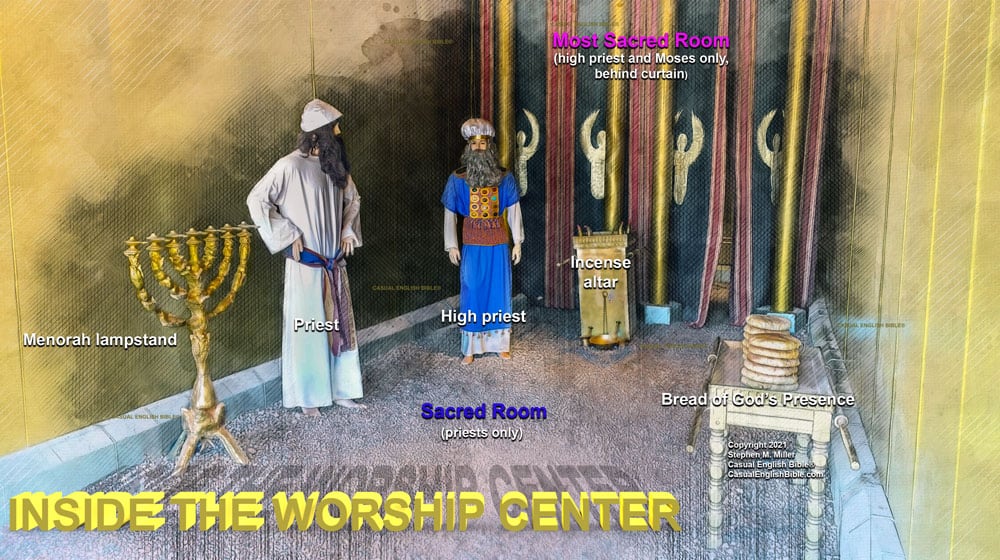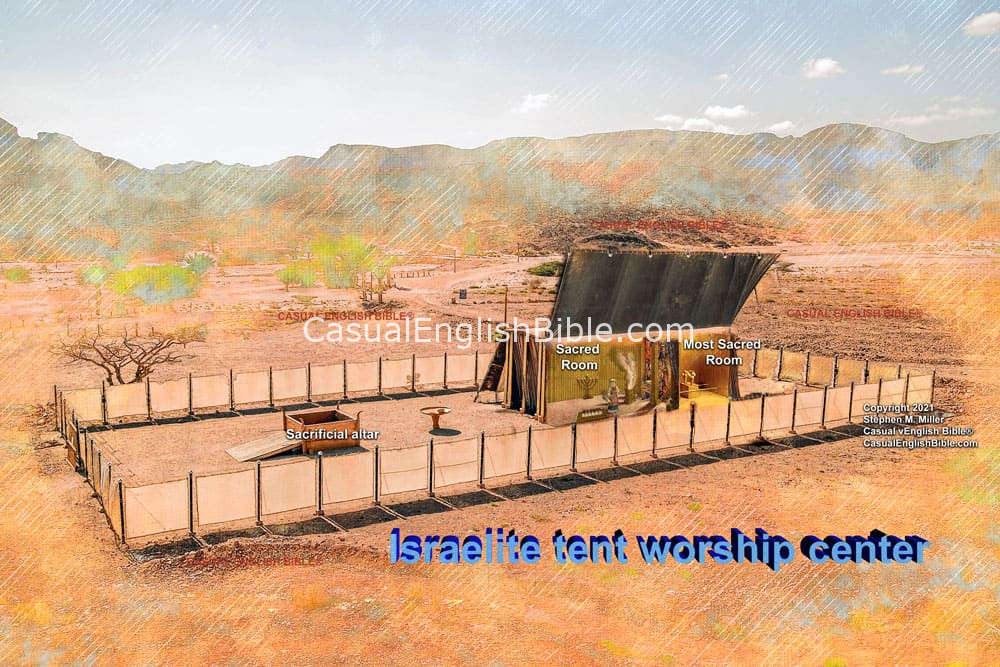Numbers 8
Levites get purified for God’s work
Lighting up the tent
1The LORD told Moses: 2Tell Aaron, “Place the menorah lampstand inside the tent worship center so it’s seven oil lamps will cast their light forward.” [1] 3Aaron did what the LORD said. He mounted the oil lamps so they projected light forward, from the front of the menorah. 4Artisans had made the lampstand from gold, which they shaped with hammers. They worked the gold from bottom to top, from the base to the flower decorations above. The LORD gave Moses the pattern that the artisans used.Levites take a bath
5The LORD told Moses: 6Call the Levites together so you can ritually cleanse them. [2] 7Here’s how I want you to do that. Sprinkle them with the special water of purification. [3] Then have them shave all the hair off their bodies, wash their bodies, and wash their clothes. After that, they’ll be ritually clean. 8Next, tell them to bring a young bull and an offering from grain—fine flour mixed with olive oil. Also, tell them to bring a second bull as a sin offering. [4] 9Call all the Israelites together in front of the tent sanctuary. That’s where I want you to present them with the cleansed Levites. 10Present the Levites to the LORD, too. Do this while the rest of the Israelites lay their hands on them. [5] 11Aaron should present the Levites to the LORD as a gratitude offering [6]—a special gift from the Israelites. Then the Levites will be ready to do the work the LORD has assigned them. 12Afterward, have the Levites lay their hands on the two bulls they brought. I want you to sacrifice one as a sin offering. Then sacrifice the other as a burnt offering. [7] This atones for sins of the Levites and keeps them on good terms with God.Moses presents Levites to God
13Have the Levites stand in front of Aaron and his sons, then present them to the LORD as a gratitude offering. 14By doing this, you’re singling out the Levites as uniquely mine. [8] 15Once you’ve done all of this, the Levites are ready to work and to serve me at the Meeting Tent. [9] But you have to ritually cleanse them first. 16Out of all the Israelites, I’m claiming the Levites for myself. They’ll take the place of the first child born in every family. 17The first child born into every Israelite family is mine. I showed that when I took the life of every first child born in Egyptian families. I did it, too, when I took the first babies of their livestock. 18Instead of taking the first child of Israelites, I’m now taking the Levites in their place. 19I’m giving the Levites as a gift to Aaron and his sons. The Levites will help the priests perform their work at the Meeting Tent. The Levites’ job is to get people back on track with the LORD by helping people atone for their sins. This will keep the Israelites out of trouble with the LORD.Moses dedicates the Levites
20Moses did what the LORD said. So did all the Israelites. They dedicated the Levites to the work of serving the LORD fulltime. 21The Levites performed the cleansing rituals God ordered so they could get rid of their sins. They washed themselves and their clothes. Aaron presented them to the LORD as a gratitude offering. And he atoned for their sins, to put them on good terms with God. 22Afterward, the Levites got to work. They went into the Meeting Tent and started operating and maintaining the sacred facility and helping Aaron and his sons. So, they did what the LORD told them to do.Retire at age 50
23The LORD told Moses: 24Levites can work in the Meeting Tent when they turn age 25. 25But when they reach age 50, it’s time for them to retire. They shouldn’t work there anymore. 26They can help someone finish a job. But the job shouldn’t be the retired Levite’s responsibility. He’s just helping out a friend who needs a hand.These are the rules I’m giving you about the Levites.
Footnotes
The lampstand stood near the front of the tent. It projected its light across the tent and toward the incense altar and the table that held the sacred bread, a few yards or meters away. The lights burned day and night for priests who ministered in the tent. There, priests burned incense offerings and, once a week, ate the dozen loaves of sacred bread on the table (Leviticus 24:8-9).
The cleansing or purification was apparently to prepare them to work on holy ground and with sacred objects at the tent worship center.
This is fresh water, such as from a stream or a spring. It’s laced with ashes of a sacrificed red heifer. See Numbers 19.
A sin offering refers to something the people of Israel brought to God after they realized they had accidentally broken one of God’s laws earlier. Some scholars say a better translation is the opposite of “sin” because the sacrifice is intended to “un-sin” people, to purify them. So those scholars call it a “purification offering.”
It’s not clear what’s going on in this scene. It seems unlikely that all the reported hundreds of thousands of Israelites could have crowded into the courtyard of the worship center. Perhaps only their leaders performed the ritual of laying hands on the Levites. It’s also unclear what the hands-on-Levites ritual meant. Scholars offer theories. For example, maybe it was to bless the Levites and to show support for the sacred work God assigned the Levites—the work of operating and maintaining the tent worship center. Others say the laying on of hands may have expressed the idea that the Levites were the Israelites’ gifts to God. Worshipers bringing sacrificial animals to God did the same with the animals, laying hands on the animals before giving them to God. The symbolism ends there because the animals died and the Levites lived the rest of their lives uniquely devoted to God.
This sacrificial offering goes by various names: fellowship offering, elevation offering, symbolic offering, special offering, and wave offering. The Hebrew word can mean to wave, lift, or blow. In Exodus 29, this sacrifice represented the culmination of an ordination service authorizing priests for ministry. It was the final act, which some scholars say was an expression of gratitude to God for allowing these men to lead the worship rituals for the people of Israel.
This was the most common animal sacrifice. Worshipers burned the entire animal.
Earlier, God told Moses, “Look, the Levites belong to me now. You used to give me the first child born in every family. But now, Levites will take their place” (Numbers 3:12). God didn’t require the Israelites to sacrifice their firstborn children, as some other religions in the region apparently did. But God had each family, in a sense, buy back the children by substituting them with animal sacrifices instead. That’s how Exodus 22:29 reports it.
Some scholars say a different writer here in Numbers—someone with ties to the Jewish priesthood—is telling a different story. He’s saying God has subbed out the firstborn children and subbed in the Levites. Perhaps another possibility is to consider the story as an illustration of how uniquely devoted to God the Levites would become. They would serve the emerging nation of Israel as the ministry tribe, as Israel’s worship leaders. Perhaps as the ancient version of today’s church bishop, with the pastors or priests under the bishop’s care, along with all of the local church ministry teams.
This is likely the tent worship center of Exodus 36-40. Yet, there was another Meeting Tent that was not the tent worship center. The Meeting Tent was mentioned first in Exodus 33:7, before the tent worship center was built and located in the middle of the camp (Numbers 2:17). This was another place where Moses apparently spent some time, “outside the camp, at a fair distance” (Exodus 33:7). This is where people would go to hear from Moses about what the Lord had to say about any question they had. Some scholars say Moses likely set up this Meeting Tent outside the camp because of God’s refusal to travel with the people. Moses may have figured that if God wouldn’t come to them, they would go to God.
Discussion Questions
- Sorry, there are currently no questions for this chapter.







